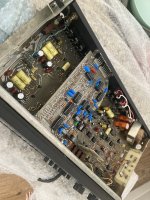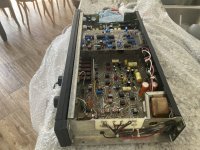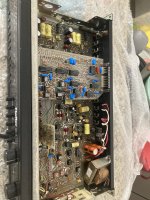I can confirm that a suitable replacement volume or balance control is 502-0312 NTE Electronics 50K OHM 1/5W LINEAR. It isn't an exact replacement as it has a slightly shorter D shaft but it's enough for both set screws to secure the knob. As a bonus the knobs now have a smoother weighted feel so it could be considered an upgrade. There's still an issue when the volume is set all the way down where sound still passes through and the balance is off. All is well when the volume is slightly raised. I tried adjusting the four trim pots but it didn't make much difference and I set them back to the original settings.
Finally found the last volume issue was simply due to some careless and not very obvious solder spatter next to the LM1458 socket. Future e-cap replacements will be done with a Hakko FR-301 desoldering tool which works amazingly well.
The VOL and BAL potentiometers are 50K (linear) as seen on the left side of the schematic. The 100K pots are trim pots that shouldn't need to be adjusted.
I've been trying to revive an Iris preamp that was non-functional. Apart from a blown fuse and a burned tantalum cap on the remote input board I didn't see anything else odd about it.
The symptom is this:
Channel Right tracks properly with regards to volume.
Channel Left does not. If you nudge the volume pot even a very small amount the volume in the right channel jumps to 3/4 volume immediately.
Nudging it back just a tiny bit causes the left output to drop back to barely audible. So a very very small increase in the volume pot cause the volume to jump drastically, but only in the left channel.
I verified that the pot is tracking correctly out-of-circuit.
I also replaced the usual 4.7 and 2.2 uF Tantalum caps that often cause issues.
Can someone point me in the right direction?
I am having trouble deciphering the schematic - it's quite complex with regards to the optical photo resistive volume controls.
Oh, and to be sure it wasn't related to the remote input board I removed it from the preamp. Same issue.
The symptom is this:
Channel Right tracks properly with regards to volume.
Channel Left does not. If you nudge the volume pot even a very small amount the volume in the right channel jumps to 3/4 volume immediately.
Nudging it back just a tiny bit causes the left output to drop back to barely audible. So a very very small increase in the volume pot cause the volume to jump drastically, but only in the left channel.
I verified that the pot is tracking correctly out-of-circuit.
I also replaced the usual 4.7 and 2.2 uF Tantalum caps that often cause issues.
Can someone point me in the right direction?
I am having trouble deciphering the schematic - it's quite complex with regards to the optical photo resistive volume controls.
Oh, and to be sure it wasn't related to the remote input board I removed it from the preamp. Same issue.
I was able to get another Iris preamp, but under the label Sound Valves
Green motherboard, no remote control board, gold plated plugs and different film capacitors
Is working fine
Are those film capacitors polypropylene?
And any good pot replacement for the balance ?
Green motherboard, no remote control board, gold plated plugs and different film capacitors
Is working fine
Are those film capacitors polypropylene?
And any good pot replacement for the balance ?
Attachments
I should have updated with my progress. I have solved the balance issue with my Iris.
First, I treated the pots with Caig FaderLube. No real improvement, but Faderlube is a good tonic for carbon potentiometers.
Second I replaced all the tantalum capacitors on the board. Several were bad.
Lastly, I re-flowed the solder on all the connection points for the optical modules. This was the fix.
The solder joints were suspect - my guess is that they were either cold-solder joints or they were corroded, and removing the old solder and applying new solver solved the issue permanently. This is a two layer board with no solder mask. Not the green one with a solder mask. Corrosion could be possible, and there was likely a bad connection to the top layer, the component side.
First, I treated the pots with Caig FaderLube. No real improvement, but Faderlube is a good tonic for carbon potentiometers.
Second I replaced all the tantalum capacitors on the board. Several were bad.
Lastly, I re-flowed the solder on all the connection points for the optical modules. This was the fix.
The solder joints were suspect - my guess is that they were either cold-solder joints or they were corroded, and removing the old solder and applying new solver solved the issue permanently. This is a two layer board with no solder mask. Not the green one with a solder mask. Corrosion could be possible, and there was likely a bad connection to the top layer, the component side.
Also good info about the Tantalums
"typically use higher voltage rated tantalum caps. If the original Tantalums were 25V then I go with a 35V rated cap in the same capacitance value. Some people will advocate for installing modern low ESR electrolytics. My theory on this is that if the original tantalum's made it 30years then the higher voltage rated tantalums should last as long or longer and I'll probably not be around by then.
The tantalum caps in the Iris are for PS decoupling in most areas around the IC's and for bypassing in the audio circuit. Tantalum caps are great in that they have very low resistance at high frequencies, they just suck in the fact that they will eventually fail and when they do they short out."
"typically use higher voltage rated tantalum caps. If the original Tantalums were 25V then I go with a 35V rated cap in the same capacitance value. Some people will advocate for installing modern low ESR electrolytics. My theory on this is that if the original tantalum's made it 30years then the higher voltage rated tantalums should last as long or longer and I'll probably not be around by then.
The tantalum caps in the Iris are for PS decoupling in most areas around the IC's and for bypassing in the audio circuit. Tantalum caps are great in that they have very low resistance at high frequencies, they just suck in the fact that they will eventually fail and when they do they short out."
- Home
- Source & Line
- Analog Line Level
- Hafler Iris Preamp balance issue - fixed




